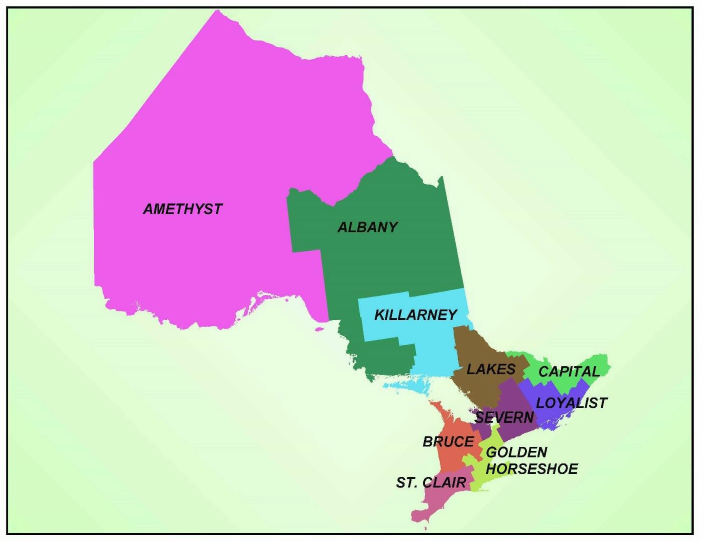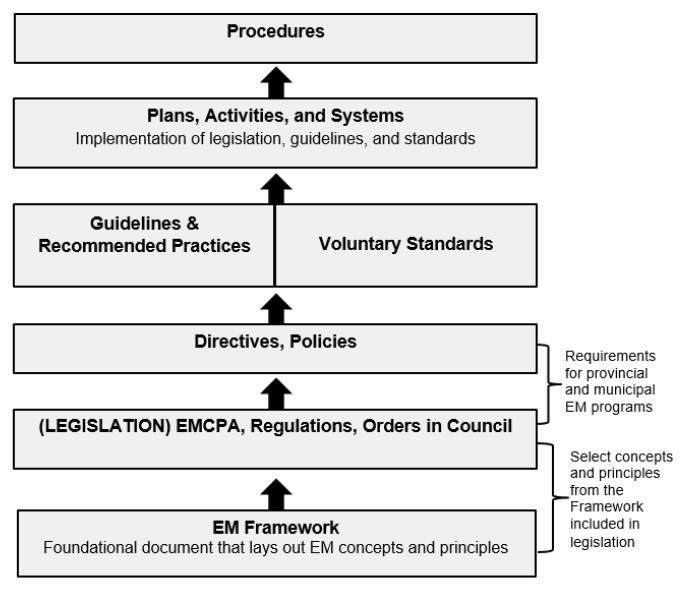Governance
In addition to the leadership and management embedded in programs for provincial government bodies and municipalities as per legislation, Ontario has established or is part of senior level committees and appointments for emergency management in Ontario.
Governance of emergency management in Ontario is developed and implemented through:
- Emergency management governance committees/appointments
- Emergency management response, program, and document structures
Emergency management governance committees and appointments
Federal, Provincial, Territorial committees:
- Senior Officials Responsible for Emergency Management
- The Standing Forum of Federal/Provincial/Territorial (FPT) Senior Officials Responsible for Emergency Management (SOREM) is responsible for coordinating a strategy for emergency management in Canada, and for providing guidance and advice on how to enhance emergency management in Canada. Members are provincial and territorial heads of emergency management organizations and the assistant deputy minister of the Emergency Management and Programs Branch of Public Safety Canada.
- Canadian Council of Emergency Management Organizations
- The Canadian Council of Emergency Management Organizations serves to foster cooperation between provinces and territories, to provide support during emergency events and to inform national discussions concerning FPT program and policy development. CCEMO was established in 2002 under the authority of provincial and territorial (PT) deputy ministers responsible for emergency management and is mandated to improve the safety of all Canadians through enhanced inter-jurisdictional coordination of emergency management practices involving all phases (prevention, mitigation, preparedness, response, recovery). While responsibility to carry out the mandate is shared amongst PTs, collaboration is sought from the federal government and national non-government public safety organizations. Membership in CCEMO consists of a lead senior official from each province and territory's emergency management organization, or their designate.
Province-wide:
- Cabinet Committee on Emergency Management (CCEM)
- This committee was created to advise the LGIC on matters relating to emergencies. Permanent membership on the CCEM consists of: Premier and President of the Executive Council, the Attorney General, Minister of Energy, Northern Development and Mines (Energy), Minister of Finance, Minister of Health, Minister of Municipal Affairs and Housing, Minister of Natural Resources and Forestry, President of the Treasury Board and the Solicitor General. Any situation or circumstance within the scope of CCEM that falls within the mandate or statutory authority of a member of the Executive Council not listed in OIC 997/2020, that member may be added to the committee for such period considered appropriate by the chair.
- Commissioner of Emergency Management
- The Commissioner of Emergency Management is appointed by Order in Council and serves at the pleasure of the LGIC for a period not exceeding three years from the effective date of their appointment. If an emergency order has been made by the LGIC or Premier, the powers (outlined by Section 7.0.2 (4) and Section 7.0.3 of the EMCPA) of the LGIC or the Premier may be delegated to the commissioner of Emergency Management.
- Chief of Emergency Management Ontario
- The chief of Emergency Management Ontario is responsible for monitoring, coordinating and assisting in the development and implementation of ministry and municipal emergency management programs. The chief is also responsible for ensuring those programs and plans are coordinated with the emergency plans of the Government of Canada and its agencies.
Provincial government bodies:
- Ministry Emergency Management Program Committee
- The purpose of this committee is to advise the minister on the development and implementation of the ministry's emergency management program. Membership includes the ministry's MEMC, a senior official appointed by the minister and ministry employees who are responsible for emergency management functions as may be appointed by the minister.
- Ministry Action Group
- The Ministry Action Group shall direct the ministry's response in an emergency, including the implementation of the ministry's emergency plan. It is also responsible for developing procedures to govern its responsibilities in an emergency. Membership consists of each deputy minister of the ministry or their designates, the senior ministry official appointed to the ministry's emergency management program committee, the MEMC and other ministry employees as may be appointed by the minister.
- Ministry Emergency Management Coordinator
- This position is responsible for co-ordinating the development and implementation of the ministry's emergency management program within the ministry and for co-ordinating the ministry's emergency management program in so far as possible with the emergency management programs of other ministries, municipalities, and organizations outside government that are involved in emergency management.
- Emergency Information Officer
- Every minister shall designate an employee of the ministry as the ministry's emergency information officer. The emergency information officer shall act as the primary media and public contact for the ministry in an emergency.
Municipalities:
- Emergency Management Program Committee
- Every municipality is required to have an Emergency Management Program Committee. The committee shall advise the municipal council on the development and implementation of the municipality's emergency management program. The committee is also responsible for conducting an annual review of the municipality's emergency management program and shall make recommendations to the council for its revision if necessary. Membership consists of the municipality's emergency management program co-ordinator, a senior municipal official appointed by the council, such members of the council as may be appointed by the council, council appointed municipal employees who are responsible for emergency management functions, and such other persons as may be appointed by the council.
- Emergency Control Group
- Every municipality is required to have a municipal emergency control group. The emergency control group is responsible for directing the municipality's response in an emergency, including the implementation of the municipality's emergency response plan. Its membership consists of council-appointed officials or employees of the municipality, or other members of the municipal council.
- Community Emergency Management Coordinator
- Every municipality is required to have an emergency management program coordinator. This community emergency management coordinator is an employee of the municipality or a member of the council. They are responsible for co-ordinating the development and implementation of the municipality's emergency management program within the municipality. In addition, they are responsible for co-ordinating with the emergency management programs of other municipalities, the provincial government and organizations outside of the government that are involved in emergency management.
- Emergency Information Officer
- Every municipality shall designate an employee of the municipality as its emergency information officer. The emergency information officer shall act as the primary media and public contact for the municipality in an emergency.
Emergency management programmatic support structure (for non-emergencies)
The flow of information and the making of decisions relevant to emergency management program matters involve many organizational bodies across Ontario. In support of the emergency management program governance structure, there are several committees and forums that have been established to enhance EM programs in Ontario.
- EMO Sectors
- EMO has established geographic sectors across the province and assigned field staff to these sectors. Field staff provide advice and assistance to municipalities within their sectors on an ongoing basis to support developing, maintaining, and enhancing municipal emergency management programs. Using the sector structure, EMO Field Staff work with municipalities' community emergency management coordinators to schedule and conduct twice-yearly sector meetings. These meetings provide a forum to exchange best practices, learn about evolving trends in emergency management, and provide updates from an EMO corporate perspective. Emergency management best practices and challenges shared by municipalities at sector meetings are used by EMO to support emergency management program enhancements and/or to identify solutions.

- Ministry Emergency Management Coordinators Committee
- The purpose of the Ministry Emergency Management Coordinators Committee (MEMCC) is to enhance inter-ministerial coordination as it relates to emergency management within the Ontario Public Service. The membership is comprised of EMO, MEMCs and directors of emergency management in ministries.
- Provincial Emergency Management Coordinators Committee
- The purpose of the Provincial Emergency Management Coordinating Committee (PEMCC) is to provide a strategic forum for advancing emergency management in Ontario. Relevant information from community emergency management coordinators are shared at Sector Meetings. Relevant information is then shared at Sector Leads Meetings, which then is shared at PEMCC which is chaired by the chief of EMO or delegate. Similarly, relevant information from MEMCC meetings are subsequently shared at PEMCC meetings. Membership currently includes municipal sector representatives (two from each of the EMO sectors), ministry emergency management coordinators (MEMCs) and alternate MEMCs, EMO, Public Safety Canada—Ontario Region. Other organizations may be invited as required.
- Nuclear Emergency Management Coordinating Committee (NEMCC)
- The purpose of the NEMCC is to ensure that an optimum state of nuclear emergency planning, preparedness, response and recovery is achieved and maintained in Ontario. Membership includes organizations at the federal, provincial, municipal and reactor facility level with responsibility for nuclear safety in the province, as stated in the PNERP Annex I. Additional representation may be requested from other relevant representatives, including, private sector organizations and those with the ability to offer scientific or technical expertise. The outcomes of all these committee meetings and forums, in the form of recommendations are brought to the chief, EMO for review and where necessary, the determination of actions to be taken. If required, the chief, EMO has the option and opportunity to refer matters to the commissioner of Emergency Management, and eventually to the Cabinet Committee on Emergency Management.
Provincial emergency response structure
The general organizational structure established for the response to an emergency that requires the coordination of activities between multiple provincial organizations is illustrated below, in Figure 6. It can also be found in the Provincial Emergency Response Plan. The depiction below is not a command and control structure. What is shown is the primary lines of communications and coordination for a multi-jurisdictional response. Each organization will make additional connections with other organizations as required by the needs of the emergency. See Appendix A for the diagram of the Provincial Emergency Response Structure.
Structure of documents and authorities
Under the constitutional division of powers in Canada, the management of public order and public emergencies is led by the provinces, with support from the federal government. Emergency management and civil protection activities undertaken in Ontario stem from the following sets of documents/authorities. The relationship between these documents/authorities is illustrated below (Figure 7). The Emergency Management Framework for Ontario is depicted at the base as the foundational and doctrinal document.

Figure descriptions
Figure 6
The EM Framework is the foundational document that lays out EM concepts and principles. It guides EM Legislation such as the EMCPA, Regulations and Orders in Council. That EM Legislation guides EM Directives and Policies, which determines EM Guidelines and Recommended Practices and Voluntary Standards. These, in turn, guide EM plans, activities and systems, which in turn determine EM Procedures. Concepts and principles from the EM Framework are included in EM Legislation, Regulations and Orders in Council. EM Legislations, Regulations and Orders in Council, as well as Directives and Policies contain requirements for provincial and municipal EM programs.